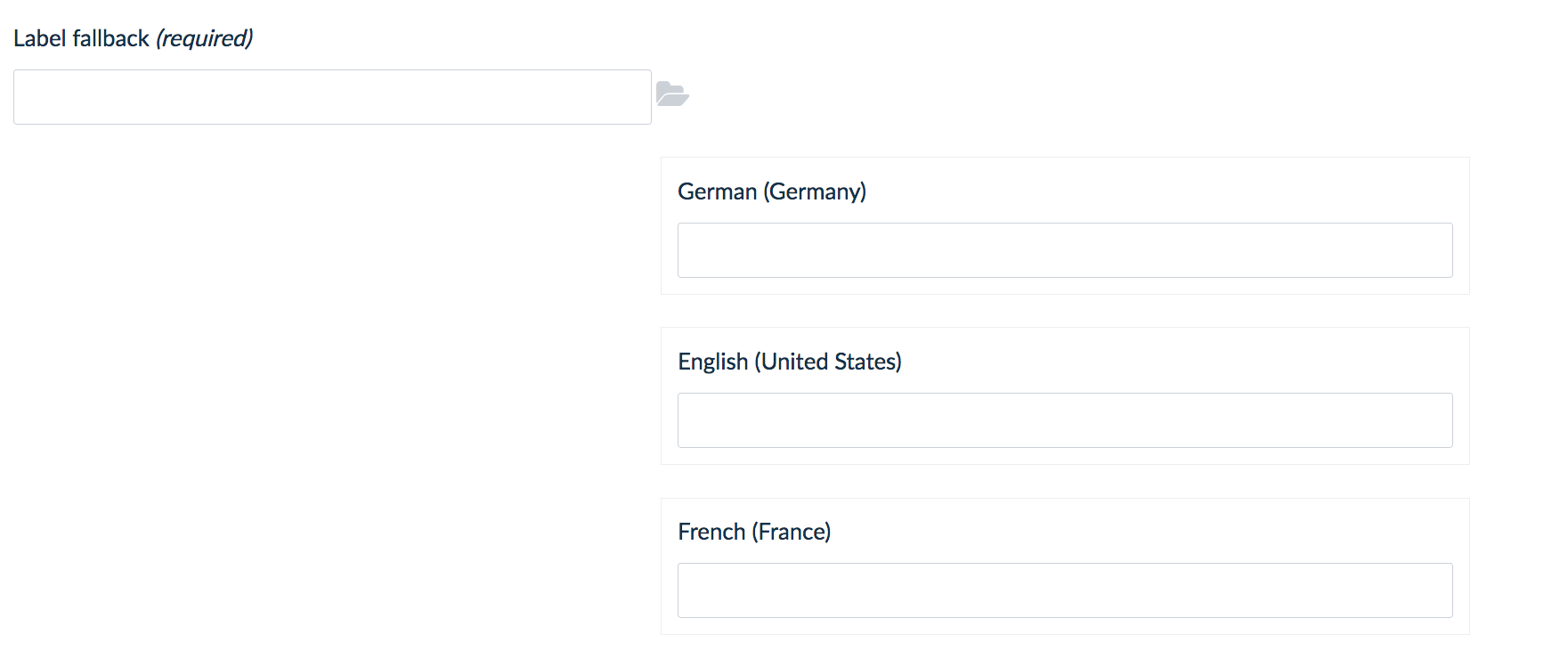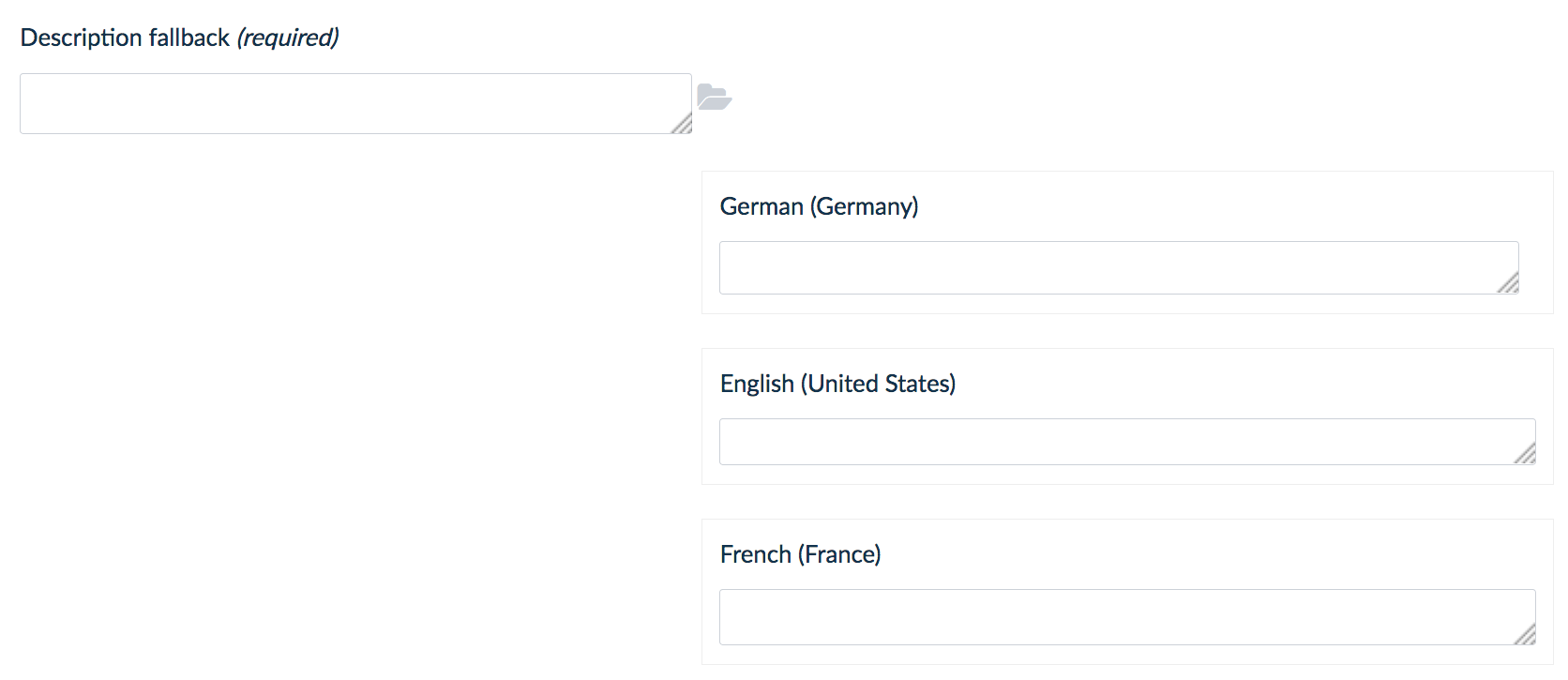kiboko / akeneo-enrich-bundle
Installs: 21
Dependents: 0
Suggesters: 0
Security: 0
Stars: 11
Watchers: 3
Forks: 1
Open Issues: 1
Type:symfony-bundle
pkg:composer/kiboko/akeneo-enrich-bundle
Requires
- akeneo-labs/custom-entity-bundle: ~1.10.0
- akeneo/pim-community-dev: ~1.7.5
This package is auto-updated.
Last update: 2025-12-21 19:55:10 UTC
README
What this project is ?
The project is an enhancement of the CustomEntityBundle from Akeneo : https://github.com/akeneo-labs/CustomEntityBundle.
What the project does ?
This bundle helps developers to create more quickly and easily custom reference data for your PIM and related views in Akeneo.
Why this project is useful ?
Custom PIM reference data are often required to meet each project's business needs and specificities.
Need help ?
If you need help concerning this bundle you can reach the Kiboko developer team at : hello@kiboko.fr or at +33 (0)471 027 223. We are open from 9am to 12:30pm and from 2pm to 5pm at Paris time.
How to: create a custom reference data
The Kiboko entity helper traits
We built 3 helper traits for common attributes that constitue most of custom entity reference data.
All of three are translatable and use an optimized UX for PIM using lots of locales at the same time.
The Custom Entity
First, you will have to create your custom entity class, in the following example we will call it Pictogram.
<?php namespace MyProject\Bundle\PictogramBundle\Entity; use Doctrine\Common\Collections\ArrayCollection; use Kiboko\Bundle\EnrichBundle\Model\DescribedInterface; use Kiboko\Bundle\EnrichBundle\Model\DescribedTrait; use Kiboko\Bundle\EnrichBundle\Model\LabeledInterface; use Kiboko\Bundle\EnrichBundle\Model\PicturedInterface; use Kiboko\Bundle\EnrichBundle\Model\PicturedTrait; use Kiboko\Bundle\EnrichBundle\Model\LabeledTrait; use Kiboko\Bundle\EnrichBundle\Model\TranslatableCustomEntityTrait; use Akeneo\Component\Localization\Model\TranslatableInterface; use Pim\Component\ReferenceData\Model\ReferenceDataInterface; class Pictogram implements TranslatableInterface, ReferenceDataInterface, DescribedInterface, LabeledInterface, PicturedInterface { use TranslatableCustomEntityTrait; use DescribedTrait; use LabeledTrait; use PicturedTrait; /** * Pictogram constructor. */ public function __construct() { $this->translations = new ArrayCollection(); } /** * Returns the custom entity name used in the configuration * Used to map row actions on datagrid * * @return string */ public function getCustomEntityName() { return 'pictogram'; } /** * Get translation full qualified class name * * @return string */ public function getTranslationFQCN() { return PictogramTranslation::class; } /** * @return string */ public static function getLabelProperty() { return 'label'; } /** * @return string */ public static function getFallbackLabelProperty() { return 'labelFallback'; } }
As you can notice, the class is implementing five interfaces :
ReferenceDataInterfaceandTranslatableInterfacefrom Akeneo bundles. If you need more information about them please refere to their documentation: https://docs.akeneo.com/1.7/index.html .DescribedInterface,LabeledInterfaceandPicturedInterfaceare provided by this bundle as helpers
The default implementation of the interfaces is made in traits:
TranslatableCustomEntityTrait, forTranslatableInterfaceandReferenceDataInterfaceconcrete implementationsDescribedTraitforDescribedInterfaceimplementationLabeledTraitforLabeledInterfaceimplementationPicturedTraitforPicturedInterfaceimplementation
Check the CustomEntityBundle documentation for explanations of the other methods declared in the example.
The Custom Entity Translation
If you wnt to managed translations you need to create a custom entity translation class,
in the following example we will call it PictogramTranslation.
<?php namespace MyProject\Bundle\PictogramBundle\Entity; use Akeneo\Component\Localization\Model\AbstractTranslation; use Kiboko\Bundle\EnrichBundle\Model\DescribedTranslationTrait; use Kiboko\Bundle\EnrichBundle\Model\LabeledTranslationTrait; use Kiboko\Bundle\EnrichBundle\Model\PicturedTranslationTrait; class PictogramTranslation extends AbstractTranslation implements LabeledTranslationInterface, DescribedTranslationInterface, PicturedTranslationInterface { use DescribedTranslationTrait; use LabeledTranslationTrait; use PicturedTranslationTrait; }
This class extends AbstractTranslation as stated by the CustomEntityBundle documentation.
It also have to implement the translation interface and use their corresponding translation helper traits :
LabeledTranslationTraitforLabeledTranslationInterfaceimplementationDescribedTranslationTraitforDescribedTranslationInterfaceimplementationPicturedTranslationTraitforPicturedTranslationInterfaceimplementation
The Doctrine configuration
In doctrine folder create the custom entity mapping in Resources/config/doctrine/Pictogram.orm.yml
MyProject\Bundle\PictogramBundle\Entity\Pictogram: type: entity table: my_pictogram repositoryClass: Pim\Bundle\CustomEntityBundle\Entity\Repository\TranslatableCustomEntityRepository changeTrackingPolicy: DEFERRED_EXPLICIT fields: id: type: integer id: true generator: strategy: AUTO code: type: string length: 100 unique: true labelFallback: type: string length: 100 nullable: true descriptionFallback: type: text nullable: true created: type: datetime gedmo: timestampable: on: create updated: type: datetime gedmo: timestampable: on: update oneToMany: translations: targetEntity: MyProject\Bundle\PictogramBundle\Entity\PictogramTranslation mappedBy: foreignKey cascade: - persist - detach oneToOne: pictureFallback: targetEntity: Akeneo\Component\FileStorage\Model\FileInfo joinColumn: name: picture_id referencedColumnName: id onDelete: CASCADE cascade: - persist
For the pictureFallback field a oneToOne relation is required to the FileInfo model.
In order to manage translations a oneToMany relation is required.
If you want to manage translation you also need to create the mapping for the translation entity in Resources/config/doctrine/PictogramTranslation.orm.yml
MyProject\Bundle\PictogramBundle\Entity\PictogramTranslation: type: entity table: my_pictogram_translation changeTrackingPolicy: DEFERRED_EXPLICIT uniqueConstraints: locale_foreign_key_idx: columns: - locale - foreign_key fields: id: type: integer id: true generator: strategy: AUTO label: type: string length: 100 nullable: true description: type: text nullable: true locale: type: string length: 20 manyToOne: foreignKey: targetEntity: MyProject\Bundle\PictogramBundle\Entity\Pictogram inversedBy: pictograms joinColumns: foreign_key: referencedColumnName: id onDelete: CASCADE oneToOne: picture: targetEntity: Akeneo\Component\FileStorage\Model\FileInfo joinColumn: name: picture_id referencedColumnName: id onDelete: CASCADE cascade: [ persist ]
Again, for the picture field a oneToOne relation is required to the FileInfomodel.
Don't forget to create migration file or update your schema:
app/console doctrine:migration:diff(preferred)app/console doctrine:schema:update --force(dangerous, reserved for advanced users)
Datagrid configuration
Your custom entity is now declared, you need to realize the data grid configuration and the form mapping.
In your bundle create a datagrid folder in it create yaml file:
Resources/config/datagrid/pictogram.yml
The section below configure the custom reference data entity to use.
datagrid: pictogram: extends: pictogram-entity-grid options: entityHint: pictogram locale_parameter: localeCode source: type: pim_datasource_default entity: MyProject\Bundle\PictogramBundle\Entity\Pictogram repository_method: createDatagridQueryBuilder columns: code: label: Code labelFallback: label: Label localizedLabel: label: Localized Label data_name: translation.label pictureFallback: label: Picture type: twig template: 'KibokoEnrichBundle:Datagrid:pictureColumn.html.twig' data_name: pictureFallback frontend_type: html created: label: Created type: product_value_datetime frontend_type: datetime updated: label: Updated type: product_value_datetime frontend_type: datetime properties: id: ~ edit_link: type: url route: pim_customentity_edit params: - id - customEntityName delete_link: type: url route: pim_customentity_delete params: - id - customEntityName actions: edit: type: navigate label: Edit the pictogram icon: edit link: edit_link rowAction: true delete: type: delete label: Delete the pictogram icon: trash link: delete_link filters: columns: code: type: string label: Code data_name: rd.code labelFallback: type: string label: Label data_name: rd.labelFallback created: type: date label: Created data_name: rd.created filter_by_having: true updated: type: date label: Updated data_name: rd.udapted filter_by_having: true sorters: columns: code: data_name: rd.code labelFallback: data_name: rd.labelFallback created: data_name: rd.created updated: data_name: rd.udapted default: code: '%oro_datagrid.extension.orm_sorter.class%::DIRECTION_ASC'
Creating the Form Type for creation and edition
In your bundle create a Form folder, and a subfolder Type.
Add inside this folder create the custom entity type class that extends CustomEntityType.
In our exemple we call it PictogramType.
<?php namespace MyProject\Bundle\PictogramBundle\Form\Type; use Kiboko\Bundle\EnrichBundle\Form\EventListener\PicturedFormListener; use Pim\Bundle\CustomEntityBundle\Form\Type\CustomEntityType; use Pim\Bundle\EnrichBundle\Form\Subscriber\DisableFieldSubscriber; use Symfony\Component\Form\FormBuilderInterface; use Symfony\Component\OptionsResolver\OptionsResolverInterface; class PictogramType extends CustomEntityType { private $formListener; public function __construct(PicturedFormListener $formListener) { $this->formListener = $formListener; } public function buildForm(FormBuilderInterface $builder, array $options) { parent::buildForm($builder, $options); $builder ->add( 'labelFallback', 'text', [ 'label' => 'my_pictogram.form.field.labelFallback.label' ] ) ->add( 'label', 'pim_translatable_field', [ 'label' => 'my_pictogram.form.field.label.label', 'field' => 'label', 'translation_class' => $options['translation_class'], 'entity_class' => $options['data_class'], 'property_path' => 'translations', ] ) ->add( 'descriptionFallback', 'textarea', [ 'label' => 'my_pictogram.form.field.descriptionFallback.label' ] ) ->add( 'description', 'pim_translatable_field', [ 'label' => 'my_pictogram.form.field.description.label', 'field' => 'description', 'translation_class' => $options['translation_class'], 'entity_class' => $options['data_class'], 'property_path' => 'translations', 'widget' => 'textarea' ] ) ->add( 'pictureFallback', 'kiboko_enrich_media', [ 'label' => 'my_pictogram.form.field.pictureFallback.label', ] ) ->add( 'picture', 'kiboko_translatable_field', [ 'label' => 'my_pictogram.form.field.picture.label', 'field' => 'picture', 'translation_class' => $options['translation_class'], 'entity_class' => $options['data_class'], 'property_path' => 'translations', 'widget' => 'kiboko_enrich_media' ] ) ->addEventSubscriber(new DisableFieldSubscriber('code')) ->addEventSubscriber($this->formListener); } /** * {@inheritdoc} */ public function setDefaultOptions(OptionsResolverInterface $resolver) { $resolver->setRequired(['translation_class']); } public function getName() { return 'my_pictogram'; } }
For each kiboko model you will use, you need to add to your form builder the correct mapping.
In our exemple we mapped label, description and picture models with their respective translatation field.
This class also need to implement :
getName(): return the form custom entity type namesetDefaultOption(OptionsResolverInterface $resolver): require to manage models translations
Now let's see to configure doctrine for our custom entity.
The Form Type configuration file
In the config folder of your bundle create a yaml file named 'form_types.yml'.
Resources/config/form_types.yml
This is where you have to mappe a form type with your custom data reference entity.
parameters: my_pictogram.form.type.pictogram.class: MyProject\Bundle\PictogramBundle\Form\Type\PictogramType services: my_pictogram.form.type.pictogram: class: '%my_pictogram.form.type.pictogram.class%' arguments: ['@kiboko_enrich.form.event_subscriber'] tags: - { name: form.type, alias: my_pictogram }
The Custom Entities configuration file
In the config folder of your bundle create a yaml file named 'custom_entities.yml'.
Resources/config/custom_entities.yml
This is where you have to define the services used for each action used in your datagrid.
custom_entities: pictogram: entity_class: MyProject\Bundle\PictogramBundle\Entity\Pictogram actions: index: service: pim_custom_entity.action.index create: form_type: my_pictogram form_options: translation_class: MyProject\Bundle\PictogramBundle\Entity\PictogramTranslation service: pim_custom_entity.action.create template: MyPictogramBundle:Pictogram:form.html.twig edit: form_type: my_pictogram form_options: translation_class: MyProject\Bundle\PictogramBundle\Entity\PictogramTranslation service: pim_custom_entity.action.edit template: MyPictogramBundle:Pictogram:form.html.twig
Form view
Now you are ready to create your custom entity form view.
Create in the views folder of your bundle a twig file named form.html.twig as specified in your
custom entities configuration file.
Resources/views/Pictogram/form.html.twig
{% extends 'PimCustomEntityBundle:CustomEntity:form.html.twig' %}
{% form_theme form.labelFallback 'KibokoEnrichBundle:CustomReferenceData:form/label.html.twig' %}
{% form_theme form.descriptionFallback 'KibokoEnrichBundle:CustomReferenceData:form/description.html.twig' %}
{% form_theme form.pictureFallback 'KibokoEnrichBundle:CustomReferenceData:form/picture.html.twig' %}
{% form_theme form.label 'KibokoEnrichBundle:CustomReferenceData:form/pim_translatable_field_row.html.twig' %}
{% form_theme form.description 'KibokoEnrichBundle:CustomReferenceData:form/pim_translatable_field_row.html.twig' %}
{% form_theme form.picture with [
'KibokoEnrichBundle:CustomReferenceData:form/pim_translatable_field_row.html.twig',
'KibokoEnrichBundle:CustomReferenceData:form/picture.html.twig'
]
%}
{% block custom_entity_form_tabs %}
<div class="AknTabContainer">
{{ elements.form_navbar(['properties']) }}
<div class="AknTabContainer-content tab-content">
{{ elements.form_errors(form) }}
<div class="tab-pane active" id="properties">
{% block custom_entity_form_properties %}
<div class="tabsections">
<div class="tabsection">
<div class="tabsection-title">{{ 'pane.accordion.general_properties' | trans }}</div>
<div class="tabsection-content">
<div class="AknFormContainer AknFormContainer--withPadding">
{{ form_row(form.code) }}
{{ form_row(form.labelFallback) }}
{{ form_row(form.label, {'attr': {'class': 'labelBlock'}}) }}
{{ form_row(form.descriptionFallback) }}
{{ form_row(form.description, {'attr': {'class': 'descriptionBlock'}}) }}
{{ form_row(form.pictureFallback) }}
{{ form_row(form.picture, {'attr': {'class': 'pictureBlock', 'displayFolder': false}}) }}
</div>
</div>
</div>
</div>
{% endblock %}
</div>
</div>
</div>
<style>
.labelBlock, .descriptionBlock, .pictureBlock.AknFieldContainer {
display: none;
width: 500px;
margin-left: 400px;
background-color: white;
border: 1px solid rgb(238, 238, 238);
padding: 10px;
}
.labelBlock:after, .descriptionBlock:after, .pictureBlock.AknFieldContainer:after {
clear: both;
}
</style>
<script type="text/javascript">
require(['jquery'], function($) {
var labelFolder = $('#labelFallbackFolder');
var descriptionFolder = $('#descriptionFallbackFolder');
var pictureFolder = $('#pictureFallbackFolder');
labelFolder.click(function() {
if(labelFolder.hasClass('icon-folder-close')) {
labelFolder.removeClass('icon-folder-close').addClass('icon-folder-open');
}else {
labelFolder.removeClass('icon-folder-open').addClass('icon-folder-close');
}
$('.labelBlock').toggle();
});
descriptionFolder.click(function() {
if(descriptionFolder.hasClass('icon-folder-close')) {
descriptionFolder.removeClass('icon-folder-close').addClass('icon-folder-open');
}else {
descriptionFolder.removeClass('icon-folder-open').addClass('icon-folder-close');
}
$('.descriptionBlock').toggle();
});
pictureFolder.click(function() {
if(pictureFolder.hasClass('icon-folder-close')) {
pictureFolder.removeClass('icon-folder-close').addClass('icon-folder-open');
}else {
pictureFolder.removeClass('icon-folder-open').addClass('icon-folder-close');
}
$('.pictureBlock.AknFieldContainer').toggle();
});
});
</script>
{% endblock %}
Kiboko, who we are ?
Kiboko is a consulting and development agency for e-commerce and business solutions, created by the reunion of 3 e-commerce seasoned developers, working on various scale of e-commerce websites. Depending on your business needs, Kiboko develops and maintains e-commerce web stores using Magento and OroCommerce. Kiboko also integrates Akeneo (PIM), OroCRM (CRM) and Marello (ERP) into pre-existing environement or into a new one to build as your business needs. Kiboko has been one of the first companies to trust OroCommerce as a true B2B e-commerce solution and one of the first to release live a web store using it.
Contributing
Please feel free to create new issues on Github




